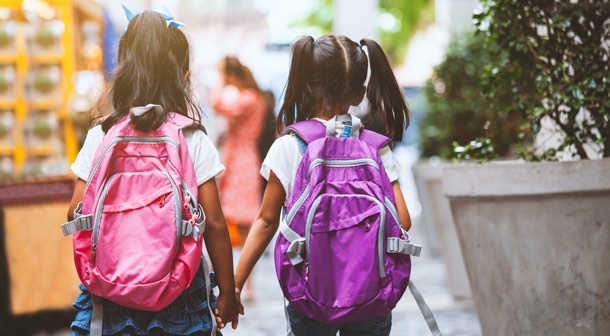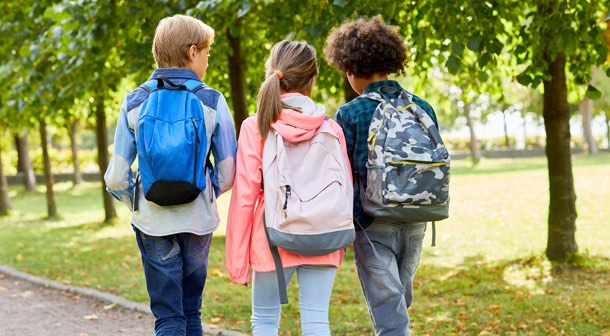Talking to Your Child about Safety
By GetParentingTips.com staff
Read Time: 9 Minutes
As a parent, you want to protect your children from anyone who might harm them. The reality is that the threat of harm can come from people your children know as well as from strangers. Keeping your child safe takes thoughtful, honest conversations that will change as your child grows up. Below are tips and helpful information for teaching children ways to stay safe.
Strangers are not the only danger.
"Stranger danger" is easy to say, but it's not the whole story. In fact:
- A child usually knows his (or her) kidnapper.
- At least 90 percent of child sexual abuse is committed by a family member or someone close to the family.
- Family members are the abusers of 49% of victims under age 6, 42% of victims ages 7 to 11, and 24% of victims ages 12 to 17.
Other dangers to children are bullying and harassment (including online), sexual exploitation and trafficking, online predators, and violence at school.
Sexual abuse can happen to children of all races and economic backgrounds. Most abusers are male (88%), and they can be any age - even another child.
Those are scary facts for a parent. But being aware of them will help you protect your kids and help them understand how to be safe from those potential dangers.
Be an alert parent.
It's important to talk about safety with children without scaring them, and it's also important to model safe behavior yourself. Staying informed about your child's whereabouts, knowing your child's friends and hangouts, and having reliable methods of staying in touch are important safety tips for when your child is not with you.
Parents and children with phones can easily stay in contact with a call or text, and you can also use child-tracking apps to know the location of your children.
When your children are old enough to go out on their own, reinforce these 4 personal safety rules, using these talking tips:
Tell me what you're doing.
Always tell me (or the other parent) what you plan to do before going anywhere or agreeing to do something.
Take a friend.
Bring a friend and practice the buddy system: Stay together!
Tell people no.
Say no if things don't feel right to you. It's okay to speak up and leave right away if you're not comfortable.
Tell a trusted adult.
Please don't keep secrets. If something weird happens, you can tell me. Always tell someone what happened. Your safety is so important.

Responding to danger
How does a child know when something feels weird? Children may find situations confusing and may not understand their feelings or know how to express them. By teaching your kids ways to identify and respond to threatening situations, you can help keep them safe.
Encourage your children to listen to their instincts if they sense something isn't right. Teaching children how to recognize their instincts is key. Explain that:
- They may feel a tightness in their chest.
- It may be that little voice inside saying the situation is not right.
- They may have a stomachache.
- It could be an odd feeling that they can't describe.
Teaching children that their gut feelings are a reaction to something real that they saw or heard validates their feelings. Teach children what to do when facing danger with tips like:
- Leave the area right away.
- Ignore strangers if they are calling out to you.
- Tell a trusted adult what happened.
Talk with your children about how to be safe from danger before they go out on their own. Consider creating the following plans:
- If they're in a store, find an employee to wait with them until you or a caregiver arrives.
- If they're at someone's house, find a place to wait safely until you or help arrives.
- When children are old enough, discuss how they can leave and meet you at a predetermined location.
Playacting is a good way for teaching children about dealing with stranger danger and other scary situations. Pretend that something scary is happening and share these safety tips with them:
- It's okay to fight back and yell for help if someone grabs or touches them inappropriately.
- It's okay to scream and make lots of commotion to get people's attention.
Need parenting help now?
The Texas Parent Helpline is available 24/7.
- Call 833-680-0611
- Chat with us
- Text 833-680-0611

Teaching children "people smarts"
Once children have learned to understand their instincts, the next step is to teach them "people smarts." Teaching children to combine their gut feelings with what they know about trustworthy people and tricky people will increase their safety.
How do you help children recognize tricky people?
- They break safety rules.
- They tell children to come with them without a parent's permission.
- They ask children to do something that doesn't feel right, like sit on their lap.
- They tell children to keep secrets.
- They ask for help when another adult should help.
- They may be someone the child knows or a stranger.
Teach your kids how to identify people they can trust and ask help from if they feel scared, such as a uniformed police officer or a mother with children.
Most people are not dangerous to children.
You want to protect your children, but you don't want them to be frightened. To avoid scaring children, teach them that most people are good but being careful is important. Tell your child that learning about tricky people is a safety precaution, like learning to look both ways before crossing the street.
To increase safety, help your child identify two trusted adults, if possible, who he (or she) can tell anything to and rely on for help. One adult should be someone at home, such as a parent, and one should be someone outside of the home such as a favorite teacher, coach, or cleric. Make sure you discuss the role with all adults who have been identified as "safety" people.

5 top tips for teaching children about safety
These 5 talking tips from experts in child safety will help you keep your child safe.
Teaching children the names of their body parts
It can be fun teaching children the names of their body parts, such as eyes and nose and toes. Naming body parts includes private body parts too, and that might feel embarrassing at first. But it gets easier. Remember that children who know about their body parts and have safety skills are less of a target to child abusers.
Teach children the medical terms for the private parts of their bodies: anus, breasts, buttocks, chest, penis, scrotum, vagina, and vulva. Remind children that those body parts are private and should not be touched by anyone but them. You can explain exceptions such as medical care.
Use these 3 tips for talking about body ownership: Early, openly, and often.
- Early. Begin the conversations early. For instance, use the right terms during diaper changes. Tell small children that their private body parts are the ones covered by their swimsuit.
- Openly. Talk about body safety openly and calmly during everyday moments, such as when you help dress your child.
- Often. Children need frequent reminders about safety, so keep the conversation going as they develop into their teen years.
Using the right terms for their body parts gives children the words they need to tell you or another adult if something bad happens to them.
Teaching children to set boundaries
Children can be trusting and may willingly hug people to say hello if you tell them to. But don't force them to do so. It may seem like good manners, but it may break boundaries that your child has consciously or unconsciously set for body ownership. Teaching children about boundaries means allowing them to decide when they want to shake hands, hug, or kiss. Making eye contact, saying hello, and waving goodbye are all good manners.
Make sure your children know it is okay not to share information, even their names, if they don't want to. Children also have the right to choose their friends. If someone does not respect their boundaries then they have a right to distance themselves from that person.
Discussing boundaries with children can help them develop a stronger sense of self, which can make them less of a target to predators and abusers.

Teaching children that some people can be tricky
Familiarize children with the 16 most common child lures used by people with bad intent:
- Affection. Abusers exploit love and trust, taking advantage of tensions such as divorce and neglect.
- Animal/pet. Abusers ask children to help look for their lost pet. Teach your children to ignore the person and quickly leave the area. This often is stranger danger.
- Assistance. Abusers ask children for directions or help carrying something. Teach your children that adults usually ask adults for help, not children. This often is stranger danger.
- Authority. Abusers in positions of power can take advantage of their status and overstep boundaries.
- Bribery. Candy, electronics, drugs, and money can lure children or teens and be used as rewards to continue the abuse and keep secrets.
- Drugs. Abusers may use drugs or alcohol to lure and incapacitate their victims.
- Emergency. Abusers may fake a crisis: "Your father has been hurt. He sent me to take you to him in the hospital." This often is stranger danger.
- Fame/Ego. Abusers may tell children they can become famous and offer them a tryout in private and tell them to keep it a secret from everyone.
- Games. Games using restraints like handcuffs can prevent children from protecting themselves or escaping.
- Hero. Abusers exploit children's emotions by threatening that something bad will happen to a hero figure, such as a teacher or parent, if they reveal the abuse.
- Job. Older teens and college-age youth can be lured by high-paying job offers or to interviews in secluded places.
- Name recognition. Abusers read nametags on children's belongings and call the child by name, creating a false sense of familiarity. This often is stranger danger.
- Online/computer. Online predators lure children through chat rooms and social media websites, learning children's personal information to arrange private meetings.
- Playmate/companionship. Abusers use their homes as a lure, supplying them with toys or other things kids might want, to create an anything-goes environment.
- Pornography. Adolescents are often curious about sex, and abusers can use pornographic material to hold their attention and normalize abuse.
- Threats/weapons. Abusers may use violence and intimidation to get children to cooperate with abuse or stay silent.
Teaching children about their right to privacy and laws that protect them
Children have a right to privacy, so guide them in identifying and setting boundaries around what is private in their life.
- Teach all members of the family to respect privacy in dressing, bathing, toileting, sleeping, and other personal activities.
- When you respect children's privacy and personal space, you teach them to respect the privacy and personal space of others.
When children are old enough to understand the idea of laws, explain that laws are in place to protect all children. Emphasize that no adult has the right to injure children by hitting, striking, or abusing them. Tell children that sexual abuse and physical abuse are against the law.
All the details of the laws aren't necessary. Just telling children that laws protect them helps them understand the importance of safety. And when children know about these laws, they may be more likely to tell you if something happens to them or if they saw or heard something weird.
Teaching children that all secrets can be told
Keeping secrets is an abuser's trick to frighten and control a child, so keeping the secret can feel safer than telling. Tricky people also may tell a child, "No one will believe you," or make threats.
Be open to what your children have to say. When your children know they can tell you anything without getting in trouble, they will be more likely to confide in you.
Talking about safety: school-age children
Once children are in school or going places without you, encourage them to tell you if there are places they don't feel safe. Your openness will help them focus on safety by being aware of their surroundings and their gut feelings. Remind children of these stranger danger and safety rules:
- Stay in well-lit areas where you can be seen.
- Be aware of your surroundings and know what's going on. Leave the area if you feel uncomfortable.
- Keep a safe distance from anyone you don't know. Give yourself room to back up or run away.
- Never get into a car with anyone you don't know.
- If you get lost, stay in one place where you feel safe, because that makes you easier to find.

Home alone: preteens and teens
Teach preteens and teens these safety rules for staying home alone:
- Keep doors locked and don't leave.
- Never let anyone in the home, even if you know them, if you don't have permission in advance.
- Never tell anyone on the phone that you are alone. Don't give callers your name, phone number, or address.
- Call 9-1-1 if you feel in danger and stay on the line.
For more resources
Find more information and resources in Local Support.




